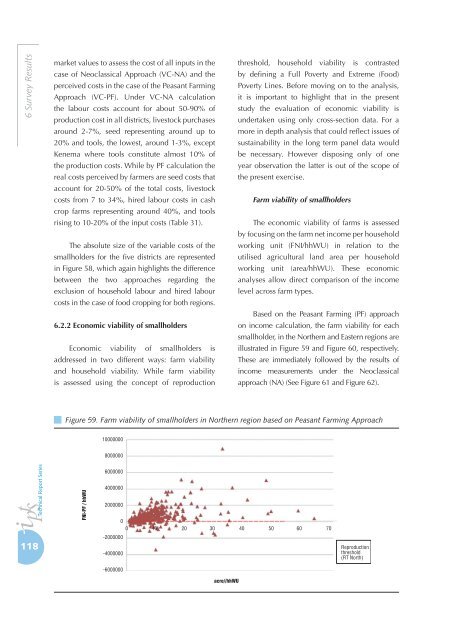SIERRA LEONE maq 4ª.indd - agrilife - Europa
SIERRA LEONE maq 4ª.indd - agrilife - Europa
SIERRA LEONE maq 4ª.indd - agrilife - Europa
Create successful ePaper yourself
Turn your PDF publications into a flip-book with our unique Google optimized e-Paper software.
6 Survey Results<br />
118<br />
market values to assess the cost of all inputs in the<br />
case of Neoclassical Approach (VC-NA) and the<br />
perceived costs in the case of the Peasant Farming<br />
Approach (VC-PF). Under VC-NA calculation<br />
the labour costs account for about 50-90% of<br />
production cost in all districts, livestock purchases<br />
around 2-7%, seed representing around up to<br />
20% and tools, the lowest, around 1-3%, except<br />
Kenema where tools constitute almost 10% of<br />
the production costs. While by PF calculation the<br />
real costs perceived by farmers are seed costs that<br />
account for 20-50% of the total costs, livestock<br />
costs from 7 to 34%, hired labour costs in cash<br />
crop farms representing around 40%, and tools<br />
rising to 10-20% of the input costs (Table 31).<br />
The absolute size of the variable costs of the<br />
smallholders for the five districts are represented<br />
in Figure 58, which again highlights the difference<br />
between the two approaches regarding the<br />
exclusion of household labour and hired labour<br />
costs in the case of food cropping for both regions.<br />
6.2.2 Economic viability of smallholders<br />
Economic viability of smallholders is<br />
addressed in two different ways: farm viability<br />
and household viability. While farm viability<br />
is assessed using the concept of reproduction<br />
threshold, household viability is contrasted<br />
by defining a Full Poverty and Extreme (Food)<br />
Poverty Lines. Before moving on to the analysis,<br />
it is important to highlight that in the present<br />
study the evaluation of economic viability is<br />
undertaken using only cross-section data. For a<br />
more in depth analysis that could reflect issues of<br />
sustainability in the long term panel data would<br />
be necessary. However disposing only of one<br />
year observation the latter is out of the scope of<br />
the present exercise.<br />
Farm viability of smallholders<br />
The economic viability of farms is assessed<br />
by focusing on the farm net income per household<br />
working unit (FNI/hhWU) in relation to the<br />
utilised agricultural land area per household<br />
working unit (area/hhWU). These economic<br />
analyses allow direct comparison of the income<br />
level across farm types.<br />
Based on the Peasant Farming (PF) approach<br />
on income calculation, the farm viability for each<br />
smallholder, in the Northern and Eastern regions are<br />
illustrated in Figure 59 and Figure 60, respectively.<br />
These are immediately followed by the results of<br />
income measurements under the Neoclassical<br />
approach (NA) (See Figure 61 and Figure 62).<br />
Figure 59. Farm viability of smallholders in Northern region based on Peasant Farming Approach
















